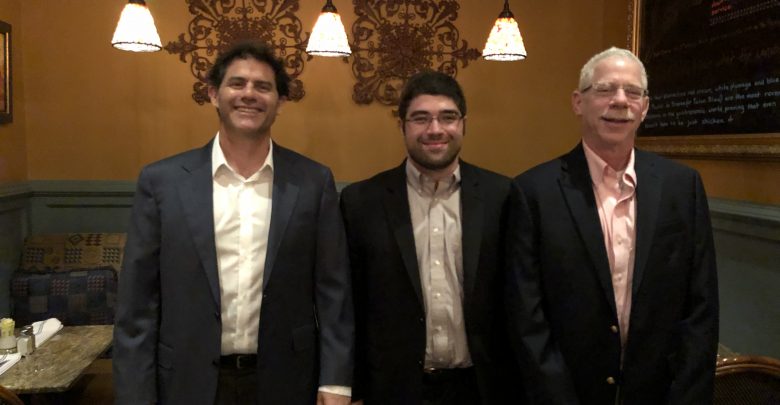Auxulin: Hyperglycemic Innovation Driven by Need
Rapid BG reduction via oral medication taken in conjunction with insulin

We spoke with Tommy Ritz, MBA, and Dr. Jason McDevitt, William & Mary’s Tech Transfer Director about Auxulin – https://auxulin.com/ – the company they founded to market a new drug that alleviates hyperglycemic episodes.
Tommy was diagnosed with Type 1 Diabetes (T1D) at age 5. “My dad Gary has been a diabetic since he was 25, so it wasn’t too weird to give myself injections and prick my finger. By 6 or 7, I was managing it by myself.”
The Need
Hyperglycemia is defined as a glucose level of 250 mg/dL (milligrams per deciliter of blood) or above. While the levels vary, Ritz has between 30 to 60 hyperglycemic periods each month.
The idea behind Auxulin came to Ritz in the winter of 2016 on the day following a hyperglycemic episode that saw his blood sugar soar to 500.
“That’s a level that usually requires hospitalization, but I didn’t go,” Ritz said. “I drank water and took insulin, enough to get it down over the course of the night.
The next day my father and I were at a CVS Pharmacy, and I turned to him and I said, ‘there should be something out there to lower your blood sugar besides insulin.’
The Search
Tommy’s father Gary is a Cleveland podiatrist and registered pharmacist. The two of them began a search that extended through U.S. patents to drugs in the development pipeline. They made deep, deep dives into academic medical journals and came up empty — but they were able to identify a few potential approaches to a solution.
The solution they found is a variation of a prescription drug that is off-patent and not widely used.
“Technically, this is a new use of an old drug,” McDevitt said. “We’re taking an old drug that is off-patent, changing the formulation, and using it for something different.
Action Profile
“The drug is taken orally. It slashes the time it takes for my blood sugar to return to normal: 45 minutes, rather than the two to three hours. In addition, I stop feeling hyperglycemic nausea within 15 minutes. I still take insulin but I don’t lose patience and overdose on insulin,” said Ritz.
Auxulin has made my hyperglycemic events routinely manageable, and allowed me to get back to my day to day life much quicker. My A1c has dropped from 7.6 to 7.1”
Other Benefits
“People with T1D can become resistant to their injected insulin during hyperglycemic episodes. The higher the blood sugar level, the more likely the body is to become insulin-resistant. Further, the longer a diabetic is hyperglycemic, the greater their risk of hospitalization and developing dangerous long-term complications.
In addition to the reduction in time to get blood sugar back to normal, Auxulin may reduce insulin usage, a potentially important benefit given the rising costs of insulin medications, but it is not a replacement for daily insulin maintenance.
Path to Market
Since the drug is available and already proven safe, the Auxulin team expects to get a 505(b)(2) designation that would speed the process of getting a new use approved for an existing drug.
Limited human testing for this new use could begin immediately.
McDevitt and Ritz will take the Auxulin story to the BIO International Convention in Philadelphia. They are scheduling pitch meetings with representatives of pharma-tech firms during the June 3-6 session.
“That’s a very big meeting for us because we have really good data,” McDevitt said. “And we’re hopeful that someone is going to want to partner with us. If they do, they will be the ones that run with it and bring it to market. If they don’t, we will be seeking investors.
Economics of Development and Marketing
Ritz and McDevitt estimate that it will take $35 million to fund drug development through Phase III trials and FDA submission. This figure seems daunting, especially given the high risks in drug development, but is much lower than the industry average.
Revenues, however, would be $180 million a year if 10% of T1D people use this drug at a cost of $100 per month. This would provide a nice financial return for Auxulin investors and partners.
Early Testing
Ritz said he and his father established a testing regimen for themselves. If one of their blood sugars was elevated above 250 mg/dL, they would take an injection of insulin, then check their levels every 15 minutes until it was below 180.
To get more accurate readings, they used an actual blood-sugar machine, rather than a continuous glucose monitor.
“It has worked every time to reduce our blood sugars from a hyperglycemic level to a normal range, usually three times faster than just taking insulin alone.”
William & Mary is a Stakeholder
Ritz said he enrolled in the MBA program at William & Mary in part to take advantage of the business school’s Executive Partners network, to get some guidance in how to take the drug to market and to develop a commercialization strategy
William & Mary has invested in Auxulin, providing funding to secure intellectual property rights as well as for McDevitt’s expertise. As a stakeholder, the university stands to gain financially from the market success of Aux-101.
McDevitt is familiar with 505(b)(2) drugs, having previously founded a company developing a new use of an old tuberculosis drug. He even used to work in a lab dedicated to Type 2 diabetes.
Sources
The Auxulin story: Diabetic misery was the mother of invention, William & Mary News